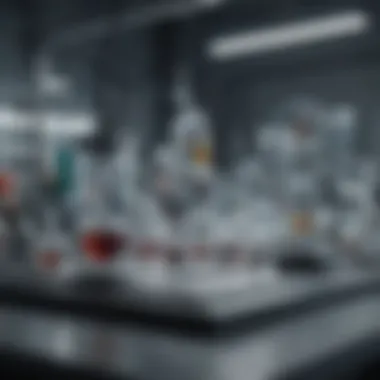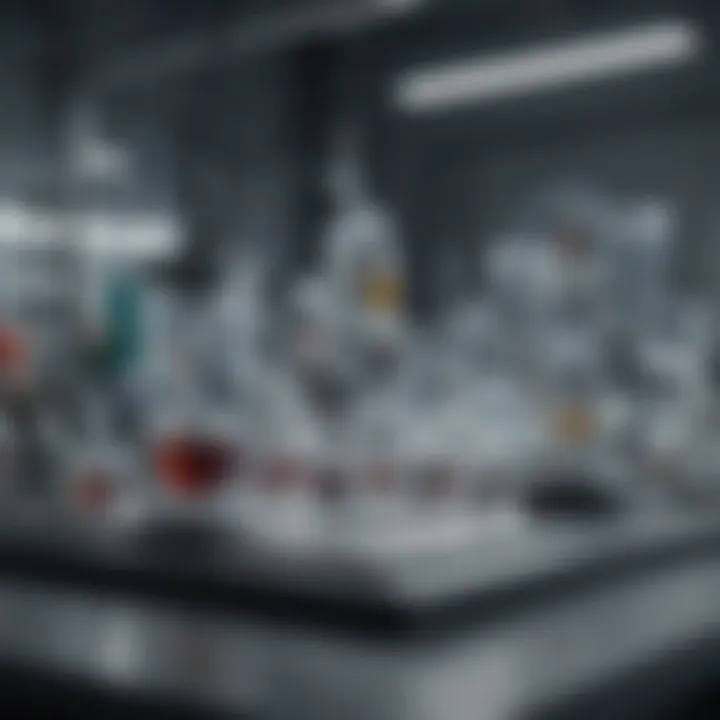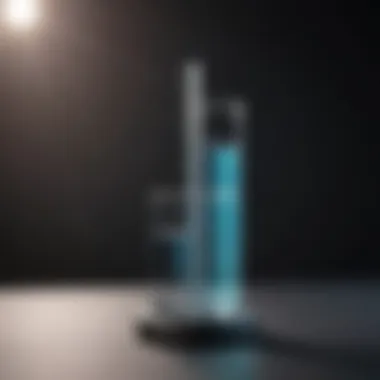A Comprehensive Guide to Oxygen Purity Testing


Summary of Objectives
This article aims to provide an extensive exploration of oxygen purity testing. The objective is to discuss the crucial role that this testing plays across various industries, such as healthcare and manufacturing. By shedding light on the techniques and standards involved, the article endeavors to enhance understanding of the implications of oxygen purity.
Importance of the Research
Oxygen purity is not merely a technical detail; it is a vital component that can affect product quality and human health. The need for accurate testing is underscored by its application in life-sustaining medical environments and precision manufacturing processes.
Prologue
Oxygen purity testing is an essential procedure that safeguards various sectors. It serves as a cornerstone in healthcare, where the quality of oxygen is vital for patient care. Similarly, in manufacturing, oxygen purity can determine the lifecycle of products and the effectiveness of processes. Moreover, environmental monitoring relies on accurate oxygen levels to assess air quality and ensure regulatory compliance.
Understanding the techniques and standards for oxygen purity testing is crucial for professionals in both healthcare and industrial settings. This guide will cover the methodologies employed, the regulatory frameworks in place, and the consequences of not adhering to purity standards.
Techniques of Oxygen Purity Testing
Testing for oxygen purity can involve several methods. Each technique is designed to suit specific needs and contexts. Common techniques include:
- Gas Chromatography: This method separates and analyzes gas samples for purity. It is accurate and widely respected.
- Paramagnetic Sensors: Utilized to measure the concentration of oxygen in a sample, these sensors are popular in many applications.
- Electrochemical Sensors: Often used in field applications, these sensors provide real-time data on oxygen purity levels.
Regulatory Standards
Regulatory bodies establish guidelines to ensure oxygen purity, influenced by the setting in which oxygen is used. For example:
- Healthcare Facilities: The Food and Drug Administration (FDA) has strict rules ensuring that oxygen used in medical settings meets specific purity levels.
- Industrial Standards: The American National Standards Institute (ANSI) outlines purity requirements for various industries, ensuring safety and efficacy.
Implications of Impurity in Oxygen
The presence of impurities in oxygen can have serious repercussions. In healthcare, impurities can compromise patient safety, leading to severe health outcomes. In manufacturing, these impurities can degrade product quality and result in costly errors.
"Oxygen purity testing is not just about compliance; it is about protecting lives and ensuring the highest quality standards."
Results and Discussion
Presentation of Findings
Findings from industry research reveal that a significant number of oxygen incidents are linked to substandard purity levels. Effective testing protocols can greatly reduce these incidents and improve overall safety in both healthcare and industrial sectors.
Implications of Results
The implications of these findings stress the necessity for rigorous testing standards. As industries evolve, the demand for pure oxygen will likely increase, necessitating improved testing methods. Continual advancement in technology must complement regulatory frameworks to address these needs effectively.
Prelude to Oxygen Purity Testing
Oxygen purity testing is a critical process with wide-ranging implications in several sectors. Both quality and safety are paramount concerns, hence the significance of oxygen purity cannot be overstated. Ensuring that oxygen meets certain purity standards is essential, particularly in environments that rely on its consistent purity for health, production, and environmental integrity. This section serves as the foundation for understanding the topic and will help to contextualize the necessity of accurate testing across various applications.
Definition and Importance
Oxygen purity refers to the concentration of oxygen in a mixture, usually expressed as a percentage. In many applications, pure oxygen is required to maintain safe and effective operational standards. Beyond the simple definition lies a more complex understanding of its importance. Impurities can lead to considerable risks, including adverse health effects in medical environments or compromised quality in manufacturing processes. A consistent testing regime can mitigate these risks and enhance reliability in operations.
Applications Across Industries
Various industries benefit from rigorous oxygen purity testing, each with unique requirements and standards. Understanding these applications provides insight into the broad relevance of this testing.
Healthcare Sector
In the healthcare sector, oxygen plays a vital role in patient treatment. It is commonly used in hospitals for respiratory therapy, surgery, and emergency care. The key characteristic here is that oxygen must be of the highest purity to avoid complications. Any contamination can lead to severe consequences for patients, potentially derailing recovery or even endangering lives. This sector's unique feature is its critical reliance on very specific purity levels, which necessitates robust purification processes and consistent testing to ensure compliance with standards such as those from the FDA. The implications of inadequate testing in healthcare can be dire, hence the emphasis on pure oxygen.
Manufacturing Industry
The manufacturing industry also relies heavily on oxygen, particularly in processes like metal fabrication and chemical production. In this context, oxygen purity is significant because it can affect the quality and effectiveness of production. An essential characteristic is that different manufacturing processes may require different purity levels, depending on the materials involved. For example, welding requires high purity to ensure that welds are strong and defect-free.
Unique features of this industry include the need for cost-effective testing methods, as many manufacturers prioritize efficiency and cost reduction. However, maintaining an optimal balance between purity and cost can be challenging. Failure to achieve required oxygen levels can lead to unsatisfactory product quality and increased operational costs due to rework or failure of processes.
Environmental Monitoring
Environmental monitoring represents another critical application of oxygen purity testing. Here, oxygen is often measured to assess air quality or monitor the health of various ecosystems. The key characteristic is the influence of oxygen levels on ecological health. For instance, low oxygen levels can indicate pollution or other environmental issues.
In this context, the unique feature includes the integration of oxygen monitoring into broader environmental regulations. Accurate testing can aid in compliance with environmental standards and ensure sustainable practices. However, potential disadvantages include the need for continuous monitoring and the associated costs. The implications of imprecise measurements can affect both policy-making and public safety—an area that demands ongoing attention.
Understanding Oxygen Purity


Understanding oxygen purity is a crucial component in various fields, such as healthcare, manufacturing, and environmental science. Oxygen plays a significant role in these sectors, thus making the purity of this essential gas paramount. Pure oxygen is often necessary for medical applications, industrial processes, and monitoring environmental conditions. In essence, ensuring oxygen purity translates to enhancing safety and effectiveness in numerous applications.
What Constitutes Pure Oxygen?
Pure oxygen is comprised of molecules that consist of two oxygen atoms (O2) without the presence of pollutants or contaminants. The minimum standard for oxygen purity is typically set at 99%. Deviations from this percentage can lead to varying degrees of effectiveness, and even danger, in specific applications.
In the healthcare field, for example, any reduction in oxygen purity could adversely affect patients who rely on oxygen supplementation. In manufacturing, impure oxygen can compromise production processes and product quality. Therefore, understanding what constitutes pure oxygen is foundational for maintaining standards across various industries.
Factors Affecting Oxygen Purity
Several factors can impact the purity of oxygen, including the source of oxygen, production methods, and storage conditions. These elements must be considered carefully to ensure the quality and effectiveness of oxygen used in various applications.
Source of Oxygen
The source of oxygen refers to where the oxygen is obtained. It can originate from natural resources, like the atmosphere, or through artificial means, such as chemical production. Atmospheric oxygen is a common choice since it is abundant and readily available. However, this approach can pose challenges. For instance, contaminants from the air can affect the purity.
On the other hand, oxygen derived from industrial processes tends to be purer. This source is favorable for sensitive applications, like medical use. Each source has its unique characteristics that affect purity, so understanding these implications is vital for accurate oxygen purity testing.
Production Methods
Various methods exist to produce oxygen, which fundamentally influence the purity levels. Techniques like cryogenic distillation or pressure swing adsorption are popular for generating high-purity oxygen. Cryogenic distillation, in particular, separates gaseous oxygen from others based on differing boiling points, yielding high purity levels.
However, these production methods also have limitations, such as energy consumption and operational costs. Evaluating these factors helps in selecting the optimal method for desired purity levels in an application.
Storage Conditions
The storage conditions of oxygen play a pivotal role in maintaining its purity. Oxygen should be stored in appropriate cylinders or containers that minimize exposure to contaminants. Poor storage methods can lead to the introduction of moisture and particulates, compromising the purity of the gas over time.
Keeping oxygen in controlled environments can preserve its quality. Temperature, humidity, and even the material of the storage container affect the integrity of oxygen. Understanding these conditions is necessary for ensuring that oxygen remains pure until it is used.
Methods of Oxygen Purity Testing
The methods used for testing oxygen purity are essential to understanding the quality of oxygen in various applications. These methods impact health and safety across different sectors. Various techniques are employed to accurately assess oxygen levels and detect impurities. Reliable testing is a requirement to ensure compliance with regulations and to maintain operational efficiency. This section will cover several established and emerging methods of oxygen purity testing, providing insights into their functionalities and benefits.
Chemical Analysis Techniques
Gas Chromatography
Gas Chromatography (GC) is a widely recognized technique for purity testing. It separates and analyzes compounds in a mixture. The core characteristic of GC is its ability to provide a clear profile of the chemical composition of a gas sample. This makes it particularly valuable for testing oxygen in various environments.
- Key Feature: It often achieves high resolution and specificity in analyses.
- Advantages: GC provides precise information about the types of impurities present in the sample. It is widely used in laboratories, owing to its reliability and established methodologies.
- Disadvantages: On the downside, this method can be time-consuming and requires skilled personnel to operate the equipment effectively.
Mass Spectrometry
Mass Spectrometry (MS) is another prominent chemical analysis technique. It identifies compounds based on their mass-to-charge ratio. The key characteristic of MS is its sensitivity; it can detect very low concentrations of gases.
- Key Feature: It offers the capability to analyze complex mixtures.
- Advantages: MS is beneficial for obtaining detailed information on the molecular structure of impurities as well as their concentrations.
- Disadvantages: One limitation is the cost associated with the equipment and required consumables. Additionally, the interpretation of data can be complex for untrained individuals.
Physical Testing Methods
Infrared Spectroscopy
Infrared Spectroscopy (IR) is a physical testing method used to analyze the absorption of infrared light by molecules. This technique is effective for identifying functional groups in gases. The unique feature of IR is its non-destructive nature, allowing for real-time monitoring of oxygen purity.
- Key Characteristic: It is particularly useful for detecting specific functional groups associated with impurities.
- Advantages: The ability to conduct measurements without sample destruction makes IR advantageous for continuous monitoring.
- Disadvantages: However, its accuracy can be influenced by the presence of water vapor and other background gases, which can complicate the readings.
Ultraviolet Analysis
Ultraviolet Analysis employs UV light to measure absorbance in gas samples. This method is effective for identifying certain contaminants because different compounds absorb light differently at specific wavelengths.
- Key Characteristic: It is efficient for detecting organic compounds that can be present as impurities.
- Advantages: This method's speed allows for quick determinations of gas purity, making it useful in fast-paced environments.
- Disadvantages: However, its effectiveness can be limited by the need for specific conditions and the types of gases being analyzed, as not all impurities absorb UV light.
Emerging Technologies in Testing
Nanotechnology Applications
Nanotechnology brings innovative solutions to oxygen purity testing. This involves using nanosensors that can detect low concentrations of impurities. The key characteristic lies in the size and sensitivity of these sensors, which significantly enhances detection capabilities.
- Key Feature: Nanosensors provide rapid response times and can be integrated into small devices, making them adaptable for various applications.
- Advantages: This method is especially beneficial for real-time monitoring in fields such as health care and environmental studies.
- Disadvantages: Nonetheless, the technology is still evolving, and there can be challenges related to manufacturing consistency and scalability of the sensors.
Electrochemical Sensors


Electrochemical Sensors are devices that measure the concentration of different gases through electrochemical reactions. They are widely used due to their ability to provide immediate results. The key characteristic is their portability and ease of use in the field.
- Key Feature: They are particularly effective for continuous monitoring of oxygen levels.
- Advantages: Electrochemical sensors can be cost-effective and simple to operate, making them a popular choice for many industries.
- Disadvantages: However, they may require regular calibration, and their lifespan can be affected by exposure to extreme environments.
Regulatory Standards and Guidelines
Regulatory standards and guidelines govern the process of oxygen purity testing, ensuring that the procedures are reliable and consistent across different sectors. The need for stringent standards arises from the critical nature of oxygen in various applications. Impurities can have dire consequences in healthcare, manufacturing, and environmental monitoring. Therefore, understanding these standards is vital for all stakeholders involved.
International Standards
ISO Standards
ISO standards, specifically the ISO 13485, are crucial in the realm of oxygen purity testing. This standard focuses on quality management systems in medical devices, directly affecting the testing processes within healthcare. One significant characteristic of ISO standards is their global acceptance, making them a popular choice for organizations seeking to comply with high quality benchmarks. Their emphasis on risk management and continuous improvement is particularly advantageous for maintaining oxygen purity.
The unique feature of ISO standards is their development process, which involves global experts. This ensures that the standards remain relevant and effective across various industries. However, a potential disadvantage could be the cost and resources required for certification, which may be a barrier for smaller companies.
ASTM Standards
ASTM standards, such as ASTM D7660, provide guidelines for various testing methods for gases, including oxygen. These standards contribute to the overall goal of maintaining accurate and reliable results in purity testing. A key characteristic of ASTM standards is their detailed and clear methodologies, making them beneficial for laboratories needing precise instructions.
One unique feature of ASTM standards is their focus on peer-reviewed processes, which enhance credibility. The main advantage of using ASTM standards is their comprehensive nature, which covers many different testing scenarios. However, like ISO standards, the complexity can sometimes overwhelm users unfamiliar with such regulations.
National Regulations
FDA Regulations
FDA regulations play a significant role in regulating oxygen testing in the United States, particularly for medical applications. These regulations ensure the safety and effectiveness of oxygen used in medical devices and therapies. A vital characteristic of FDA regulations is their focus on public health safety, making them essential in the healthcare sector. They are a beneficial guideline as they provide a clear framework for compliance that organizations can follow.
The unique feature of FDA regulations is their rigor in establishing testing protocols. This thoroughness helps prevent the use of impure oxygen in critical healthcare situations. However, navigating through the regulatory landscape can be complex, leading to potential delays in product approval for companies.
OSHA Guidelines
OSHA guidelines are crucial for ensuring safety in workplaces where oxygen is used or produced. These guidelines cover various aspects such as exposure limits and equipment standards. A key characteristic of OSHA guidelines is their strict focus on worker safety, which benefits industries that utilize oxygen in their processes.
The distinct feature of OSHA guidelines is their enforceability, providing a legal framework that protects workers’ health. They help organizations maintain a safe environment while using or testing oxygen. However, the downside may be that some smaller firms might find compliance challenging due to the required knowledge of safety procedures.
Ensuring oxygen purity through adherence to regulatory standards is crucial in eliminating risks across industries.
Understanding and implementing these standards can significantly enhance operational safety and product reliability.
Implications of Impure Oxygen
Understanding the implications of impure oxygen is crucial for various sectors. Impurity in oxygen can lead to significant health risks, industrial consequences, and environmental impacts. This section will delve into each of these areas, highlighting the dangers posed by contaminated oxygen and the necessity for stringent testing.
Health Risks
Impure oxygen poses direct health risks to humans. It is essential for respiration, and any contamination can lead to serious health issues. The presence of carbon dioxide, moisture, or other gases in oxygen can affect respiratory function. In patients who rely on oxygen therapy, such as those with chronic obstructive pulmonary disease (COPD) or pneumonia, impure oxygen can lead to worsened symptoms and complications. Some potential health issues include:
- Hypoxia: Inadequate oxygen supply to the body’s tissues, leading to organ failure.
- Respiratory Distress: Difficulty in breathing due to compromised oxygen levels.
- Infections: Contaminated oxygen might introduce pathogens, leading to respiratory infections.
Monitoring and ensuring purity is not just for health professionals but also vital for caregivers and family members of those with respiratory conditions.
Industrial Consequences
In industrial settings, the purity of oxygen is just as significant. Many manufacturing processes utilize oxygen in critical applications, such as steel production or chemical synthesis. If oxygen purity is compromised, the outcomes can be detrimental. Consider the following:
- Reduced Product Quality: Impure oxygen can lead to the generation of substandard products. In industries like pharmaceuticals, this could mean ineffective medications.
- Operational Inefficiency: Equipment may malfunction due to impure oxygen, leading to downtime and financial losses.
- Increased Safety Risks: Contaminants can increase the likelihood of accidents in environments where controlled combustion is essential. This can lead to explosions or fires, directly endangering lives.
Companies must prioritize oxygen testing to mitigate these risks and maintain safety and quality standards.
Environmental Impact
The environmental ramifications of impure oxygen should not be underestimated. Oxygen is a critical part of the Earth's atmosphere, and any degradation can affect air quality and ecological balance. Some noteworthy effects include:
- Air Quality Degradation: In areas where oxygen is used extensively, impurities can increase air pollutants, affecting local ecosystems and human health.
- Impact on Biodiversity: Altered oxygen levels can affect aquatic life and terrestrial plants that rely on specific atmospheric conditions.
- Climate Change Effects: Industrial emissions and improper handling of oxygen could contribute further to greenhouse gas accumulation.
To conclude, the implications of impure oxygen extend far beyond immediate health risks. They encompass widespread industrial challenges and environmental repercussions, making it imperative that rigorous oxygen purity testing is conducted across all fields.
"The purity of oxygen is not only a matter of industrial efficiency but also a matter of health and environmental integrity."
Ensuring that the oxygen we use is pure guarantees safety and quality, emphasizing the need for vigilant testing protocols.


Best Practices for Ensuring Oxygen Purity
Ensuring oxygen purity is vital in various sectors, especially where safety and quality are paramount. Knowing the best practices for oxygen purity testing can prevent serious health risks and industrial setbacks. The implementation of these practices not only promotes safety but also enhances operational efficiency.
Routine Testing Procedures
Routine testing procedures are essential for maintaining the integrity of oxygen purity. Regular assessments can identify any discrepancies that may arise over time. Testing should include multiple parameters, such as concentration levels and the presence of impurities. It is advisable to adopt a schedule that considers the demands of the specific application.
Some important methods used during routine testing include:
- Gas Chromatography: This method separates and analyzes the gaseous components of oxygen.
- Infrared Spectroscopy: This technique detects specific gases based on their absorption of infrared light.
Implementing these techniques routinely can help in identifying potential issues before they escalate.
Maintenance of Equipment
Proper maintenance of testing equipment cannot be overstated. Equipment used for oxygen testing must be calibrated and serviced regularly. This helps ensure that the results from the equipment are reliable. Lack of proper maintenance may lead to inaccurate readings, resulting in poor decision-making.
Key aspects to consider include:
- Calibration: Tools should be calibrated at regular intervals according to the manufacturer's specifications.
- Cleaning: Keeping equipment clean prevents contamination, which can skew results.
Keeping a log of maintenance activities can also help track performance over time.
Staff Training and Protocols
Well-trained staff is a cornerstone of effective oxygen purity management. Training ensures that personnel understand the importance of the procedures and the potential impact of impurity. Staff should receive comprehensive training on how to operate testing equipment accurately and safely.
Important training aspects include:
- Understanding Procedures: Staff must be familiar with the routine testing and maintenance procedures.
- Emergency Protocols: Knowing what to do in case of contamination or equipment failure is critical.
Regular refreshers will help maintain staff knowledge and awareness of any new updates in technologies or standards.
Ensuring oxygen purity is not just about testing; it encompasses thorough procedures and a culture of safety and quality.
Future Trends in Oxygen Purity Testing
Oxygen purity testing is undergoing significant evolution. As industries become more reliant on precise measurements, elevated standards are anticipated. These future trends highlight the ongoing advancements and integration of modern technologies pivotal for improving testing accuracy. It is crucial to understand these trends as they facilitate not only compliance with rigorous regulations but also enhance operational efficiency.
Advancements in Analytical Techniques
One main trend is the advancement in analytical techniques. Traditional methods have served well, but there is a clear shift towards more sophisticated approaches. Techniques such as high-resolution gas chromatography and improved mass spectrometry are becoming more commonplace.
These advancements provide the following benefits:
- Higher accuracy in measuring minute concentrations of impurities.
- Faster response times during testing, which aids in real-time monitoring.
- Broader range of detectable gases, expanding the scope of analysis.
As industries develop, these innovations ensure that oxygen purity testing remains competitive and precise. Adapting to these changes will be critical for laboratories and facilities,
Integration of AI and Automation
Another significant trend is the integration of AI and automation in oxygen purity testing. AI technologies enable systems to learn from data and improve predictions about purity levels. Automation increases the efficiency of testing processes.
Key considerations include:
- Implementation of smart sensors that can automatically sample and analyze oxygen purity using algorithms.
- Use of data analytics for maintaining ongoing trend monitoring, enhancing decision-making processes.
- Reduction in human error during testing, thereby increasing reliability in results.
This integration is not only about improving efficiency but also about ensuring safety in sectors such as healthcare and manufacturing. Organizations must recognize the growing necessity for these innovative solutions
"The future of oxygen purity testing lies in precision and technology integration, ensuring industries uphold the highest standards."
In summary, both advancements in analytical techniques, alongside the incorporation of AI and automation, will shape the oxygen purity testing landscape. Understanding these developments is vital for professionals in the field to remain ahead of the curve and ensure optimal practices in maintaining purity standards.
Ending
The conclusion serves as a vital section that encapsulates the central themes presented in this article. Oxygen purity testing is not merely an ancillary procedure; it is paramount across several critical domains, notably healthcare, manufacturing, and environmental stewardship. By synthesizing the key points raised throughout, this section underscores the necessity for rigorous testing protocols and compliance with established regulatory standards.
Summary of Key Points
A robust understanding of oxygen purity testing involves several integral components:
- Definition and Importance: Oxygen purity testing verifies whether the oxygen used in various sectors meets required purity levels. This is crucial for safety and efficacy.
- Testing Methods: Various techniques such as gas chromatography and infrared spectroscopy provide insights into the purity levels of oxygen.
- Regulatory Compliance: Ensuring adherence to standards set forth by organizations such as ISO and ASTM is necessary for maintaining quality assurance.
- Implications of Impure Oxygen: Failure to identify or rectify issues pertaining to oxygen purity can lead to significant health risks, environmental degradation, and economic losses.
- Best Practices: Implementing regular testing, maintaining equipment, and training personnel contribute to achieving optimal oxygen purity.
- Future Trends: The integration of advanced technologies, including AI and nanotechnology, points to an exciting evolution in testing methodologies.
Importance of Vigilance in Testing
Constant vigilance in oxygen purity testing is imperative. The consequences of lapses in testing can be dire. Impure oxygen can lead to:
- Health Concerns: In healthcare settings, patients rely on pure oxygen for treatments. Any contamination can result in severe complications.
- Operational Failures: In manufacturing, impurity could disrupt processes and affect product quality, leading to recalls and financial setbacks.
- Environmental Damage: Monitoring oxygen purity contributes to environmental protection. Impurities can indicate broader ecological issues that need urgent attention.















